2006 FORD SUPER DUTY warning
[x] Cancel search: warningPage 2 of 72

CALIFORNIA Proposition 65 Warning
WARNING:Engine exhaust, some of its constituents, and certain
vehicle components contain or emit chemicals known to the State
of California to cause cancer and birth defects or other reproductive
harm. In addition, certain fluids contained in vehicles and certain products
of component wear contain or emit chemicals known to the State of
California to cause cancer and birth defects or other reproductive harm.
Your new diesel engine will feel, drive and function somewhat differently
than a gasoline engine. Therefore it is very important that you read and
thoroughly familiarize yourself and others operating the vehicle with this
guide.
This guide will acquaint you with the 6.0L Power Stroke diesel engine. It
provides recommendations on engine care and operating procedures. For
complete vehicle information, also refer to the Owner’s Guideincluded
with the vehicle. It also describes equipment and gives specifications for
equipment that was in effect when this guide was approved for printing,
and should be considered a permanent part of the vehicle.
Some aftermarket products may cause severe engine and/or
transmission damage; refer to the “What is not covered” section
in “The new vehicle limited warranty for your vehicle” chapter of
your vehicle’s “Warranty Guide” for more information. Your
vehicle’s Powertrain Control Systems can detect and store
information about vehicle modifications that increase horsepower
and torque output. This information cannot be erased and will
stay in the system’s memory even if the modification is removed.
The Information can be retrieved by Ford Motor Company, Ford
of Canada, and service and repair facilities when servicing your
vehicle. This information may be used to determine if repairs will
be covered by warranty.
Ford may discontinue models or change specifications without any notice
and without incurring obligations.
Important notice
Ford vehicles are suitable for producing ambulances only if equipped
with the Ford ambulance preparation package. In addition, Ford urges
ambulance manufacturers to follow the recommendation of the Ford
Incomplete Vehicle Manual, Ford Truck Body Builder’s Layout Book
(and pertinent supplements) and the Qualified Vehicle Modifiers
Guidelines . Using a Ford vehicle without the Ford ambulance
2006 Econoline (eco)
Supplement
USA (fus)
Introduction
2
Page 3 of 72
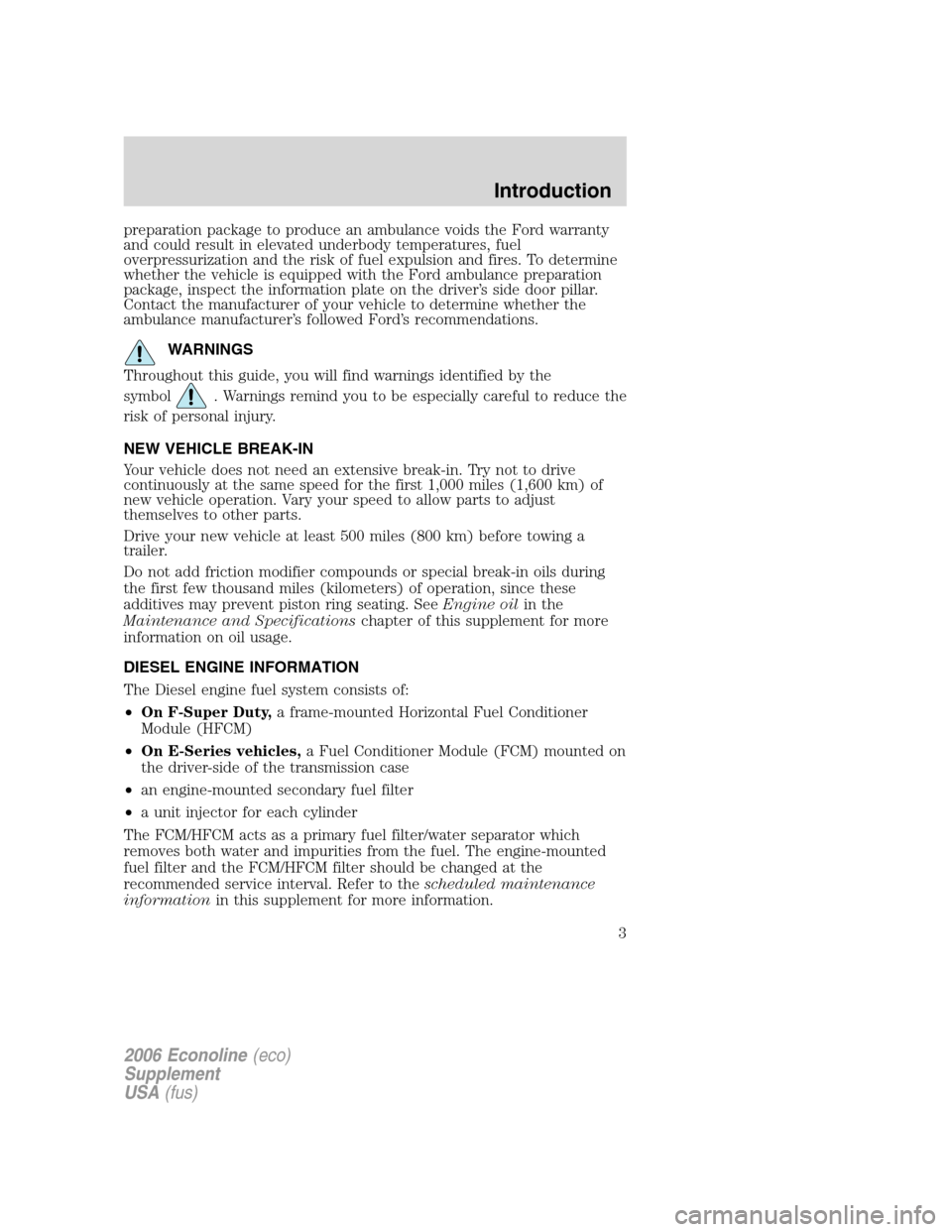
preparation package to produce an ambulance voids the Ford warranty
and could result in elevated underbody temperatures, fuel
overpressurization and the risk of fuel expulsion and fires. To determine
whether the vehicle is equipped with the Ford ambulance preparation
package, inspect the information plate on the driver’s side door pillar.
Contact the manufacturer of your vehicle to determine whether the
ambulance manufacturer’s followed Ford’s recommendations.
WARNINGS
Throughout this guide, you will find warnings identified by the
symbol
. Warnings remind you to be especially careful to reduce the
risk of personal injury.
NEW VEHICLE BREAK-IN
Your vehicle does not need an extensive break-in. Try not to drive
continuously at the same speed for the first 1,000 miles (1,600 km) of
new vehicle operation. Vary your speed to allow parts to adjust
themselves to other parts.
Drive your new vehicle at least 500 miles (800 km) before towing a
trailer.
Do not add friction modifier compounds or special break-in oils during
the first few thousand miles (kilometers) of operation, since these
additives may prevent piston ring seating. SeeEngine oilin the
Maintenance and Specificationschapter of this supplement for more
information on oil usage.
DIESEL ENGINE INFORMATION
The Diesel engine fuel system consists of:
•On F-Super Duty,a frame-mounted Horizontal Fuel Conditioner
Module (HFCM)
•On E-Series vehicles,a Fuel Conditioner Module (FCM) mounted on
the driver-side of the transmission case
•an engine-mounted secondary fuel filter
•a unit injector for each cylinder
The FCM/HFCM acts as a primary fuel filter/water separator which
removes both water and impurities from the fuel. The engine-mounted
fuel filter and the FCM/HFCM filter should be changed at the
recommended service interval. Refer to thescheduled maintenance
informationin this supplement for more information.
2006 Econoline(eco)
Supplement
USA(fus)
Introduction
3
Page 8 of 72
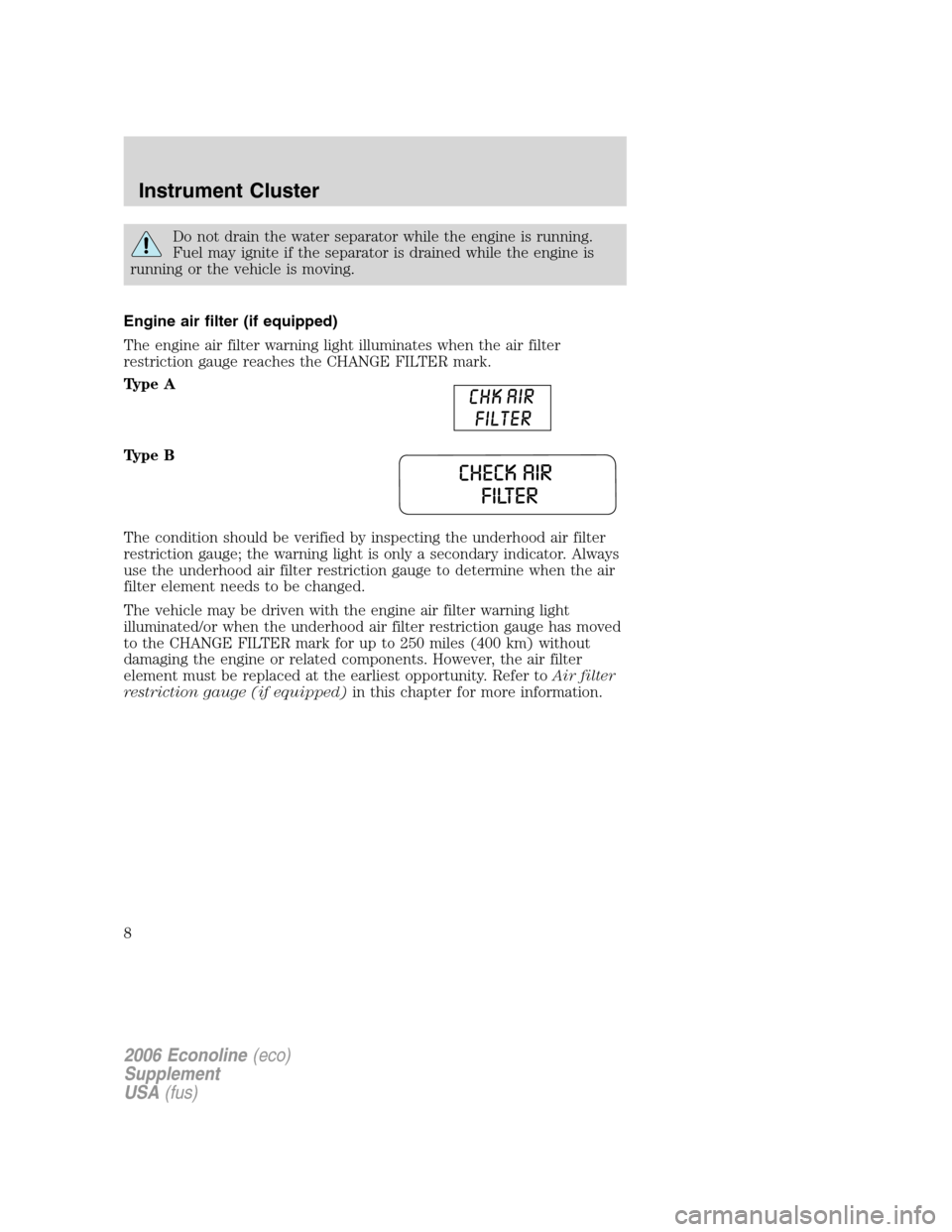
Do not drain the water separator while the engine is running.
Fuel may ignite if the separator is drained while the engine is
running or the vehicle is moving.
Engine air filter (if equipped)
The engine air filter warning light illuminates when the air filter
restriction gauge reaches the CHANGE FILTER mark.
Type A
Type B
The condition should be verified by inspecting the underhood air filter
restriction gauge; the warning light is only a secondary indicator. Always
use the underhood air filter restriction gauge to determine when the air
filter element needs to be changed.
The vehicle may be driven with the engine air filter warning light
illuminated/or when the underhood air filter restriction gauge has moved
to the CHANGE FILTER mark for up to 250 miles (400 km) without
damaging the engine or related components. However, the air filter
element must be replaced at the earliest opportunity. Refer toAir filter
restriction gauge (if equipped)in this chapter for more information.
2006 Econoline(eco)
Supplement
USA(fus)
Instrument Cluster
8
Page 9 of 72
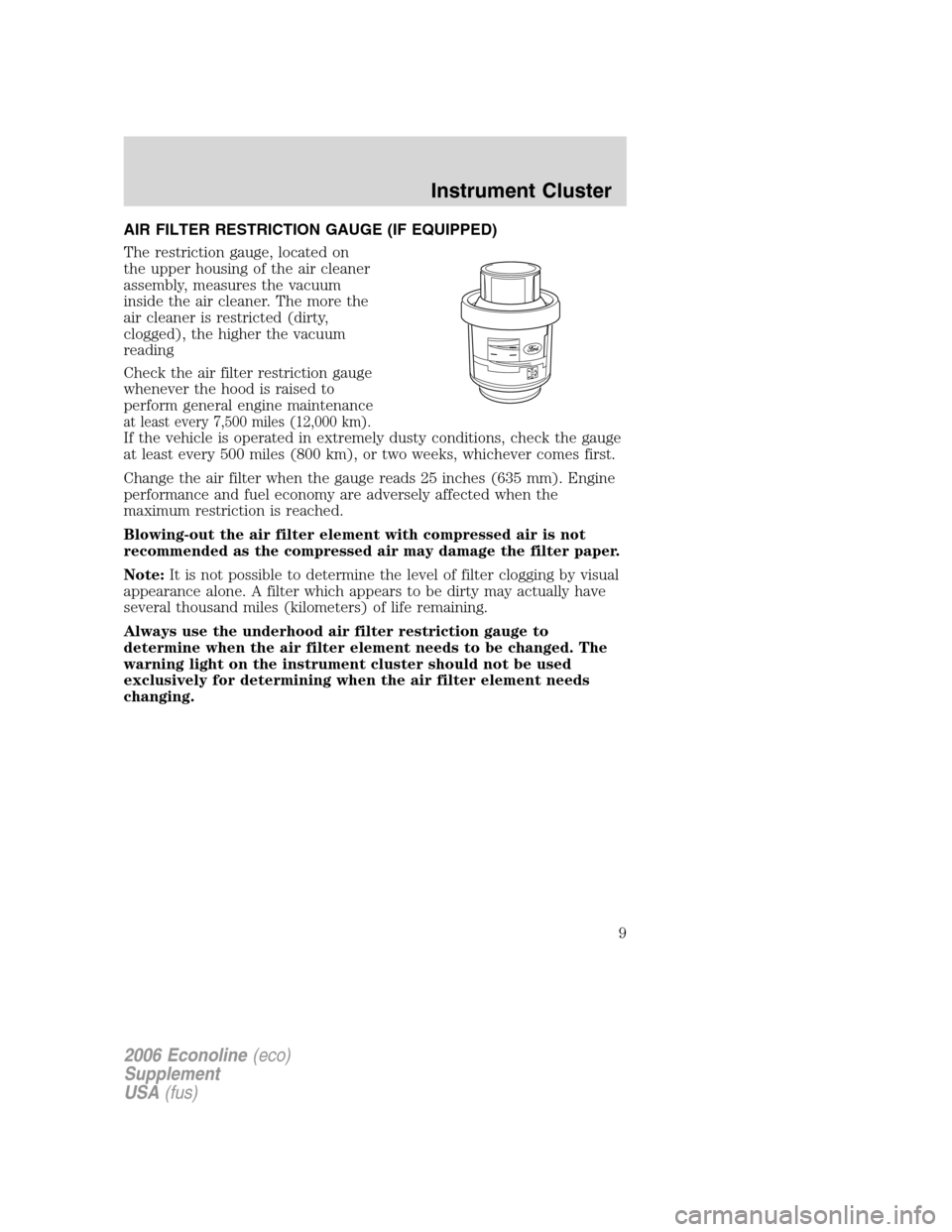
AIR FILTER RESTRICTION GAUGE (IF EQUIPPED)
The restriction gauge, located on
the upper housing of the air cleaner
assembly, measures the vacuum
inside the air cleaner. The more the
air cleaner is restricted (dirty,
clogged), the higher the vacuum
reading
Check the air filter restriction gauge
whenever the hood is raised to
perform general engine maintenance
at least every 7,500 miles (12,000 km).
If the vehicle is operated in extremely dusty conditions, check the gauge
at least every 500 miles (800 km), or two weeks, whichever comes first.
Change the air filter when the gauge reads 25 inches (635 mm). Engine
performance and fuel economy are adversely affected when the
maximum restriction is reached.
Blowing-out the air filter element with compressed air is not
recommended as the compressed air may damage the filter paper.
Note:It is not possible to determine the level of filter clogging by visual
appearance alone. A filter which appears to be dirty may actually have
several thousand miles (kilometers) of life remaining.
Always use the underhood air filter restriction gauge to
determine when the air filter element needs to be changed. The
warning light on the instrument cluster should not be used
exclusively for determining when the air filter element needs
changing.
2006 Econoline(eco)
Supplement
USA(fus)
Instrument Cluster
9
Page 10 of 72

After installation of the new filter
element, reset the gauge by pressing
the reset button on top of the
gauge.
Note:If the vehicle is operated in a
heavy snow storm, in blowing snow
or the vehicle is equipped with a
snowplow, the engine air filter
element may become partially
clogged with snow and/or ice. If this
occurs, the engine may experience a
significant reduction in power output. The vehicle may be driven under
these conditions for up to 100 miles (160 km) without damage to the
engine or related components.
At the earliest opportunity, clear all snow and ice from the air induction
system and reset the restriction gauge by pressing the button on the end
of the gauge. If the air filter restriction gauge reads 25 inches (635 mm)
after clearing snow and/or ice, then replace the filter. Reset filter
restriction gauge after changing the air filter element.
The air filter warning light on the instrument cluster may be used, in
addition to the underhood restriction gauge, to monitor the condition of
the air filter element. Refer to theEngine air filterwarning light in this
chapter of the supplement.
Engine boost gauge (if equipped)
Indicates the amount of pressure in
the engine. Driving with your
pointer continuously at the high end
of the scale may damage the engine.
2006 Econoline(eco)
Supplement
USA(fus)
Instrument Cluster
10
Page 31 of 72
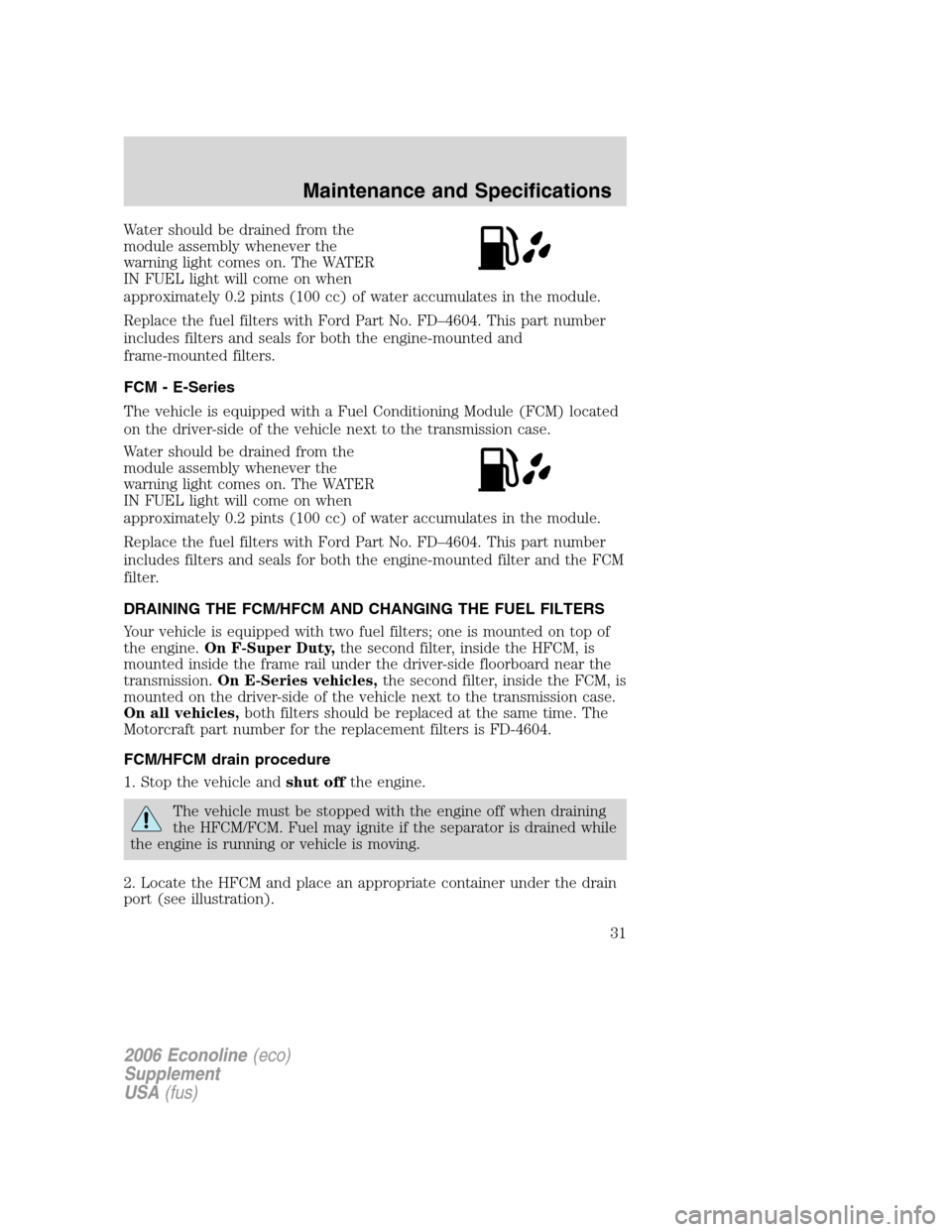
Water should be drained from the
module assembly whenever the
warning light comes on. The WATER
IN FUEL light will come on when
approximately 0.2 pints (100 cc) of water accumulates in the module.
Replace the fuel filters with Ford Part No. FD–4604. This part number
includes filters and seals for both the engine-mounted and
frame-mounted filters.
FCM - E-Series
The vehicle is equipped with a Fuel Conditioning Module (FCM) located
on the driver-side of the vehicle next to the transmission case.
Water should be drained from the
module assembly whenever the
warning light comes on. The WATER
IN FUEL light will come on when
approximately 0.2 pints (100 cc) of water accumulates in the module.
Replace the fuel filters with Ford Part No. FD–4604. This part number
includes filters and seals for both the engine-mounted filter and the FCM
filter.
DRAINING THE FCM/HFCM AND CHANGING THE FUEL FILTERS
Your vehicle is equipped with two fuel filters; one is mounted on top of
the engine.On F-Super Duty,the second filter, inside the HFCM, is
mounted inside the frame rail under the driver-side floorboard near the
transmission.On E-Series vehicles,the second filter, inside the FCM, is
mounted on the driver-side of the vehicle next to the transmission case.
On all vehicles,both filters should be replaced at the same time. The
Motorcraft part number for the replacement filters is FD-4604.
FCM/HFCM drain procedure
1. Stop the vehicle andshut offthe engine.
The vehicle must be stopped with the engine off when draining
the HFCM/FCM. Fuel may ignite if the separator is drained while
the engine is running or vehicle is moving.
2. Locate the HFCM and place an appropriate container under the drain
port (see illustration).
2006 Econoline(eco)
Supplement
USA(fus)
Maintenance and Specifications
31
Page 50 of 72

Multi-point Inspection
In order to keep your vehicle running right, it is important that you have
the systems on your vehicle checked regularly. This can help identify any
potential issue before there are any problems. Ford Motor Company
suggests the following multi-point inspection to be performed at every
scheduled maintenance as the way to ensure your vehicle keeps running
right.
Check every month
❑Check function of all interior and exterior lights❑Check tires for wear and adjust air pressure (including spare tire)
❑Check engine oil level
❑Check windshield washer fluid level
❑Check and drain fuel filter/water separator
Check every six months
❑Check lap/shoulder belts and seat latches for wear and function❑Check that externally-mounted spare tire is tight (seeOwner’s Guide)
❑Check power steering fluid level
❑Check washer spray, wiper operation and clean all wiper blades (replace as necessary)
❑Check parking brake for proper operation
❑Check and lubricate all hinges, latches and outside locks
❑Check and lubricate door rubber weatherstrips
❑Check and clean body and door drain holes
❑Check safety warning lamps (brake, ABS, air bag, safety belt) for operation
❑Check cooling system fluid level and coolant strength
❑Check battery connections and clean if necessary
❑Check clutch fluid level, if equipped
Retightening lug nuts
❑On vehicles equipped with single rear wheels, retighten the lug nuts to the specified torque at 500 miles (800 km) after
any wheel disturbance (tire rotation, changing a flat tire, wheel removal, etc.).
❑On vehicles equipped with dual rear wheels, retighten the wheel lug nuts to the specified torque at 100 miles (160 km),
and again at 500 miles (800 km) of new vehicle operation and after any wheel disturbance (tire rotation, changing a flat
tire, wheel removal, etc.).
❑Refer toWheel Lug Nut Torque Specificationin yourOwner’s Guidefor the proper lug nut torque specification.
2006 Econoline (eco)
Supplement
USA (fus)
Scheduled Maintenance Guide
50
Page 51 of 72
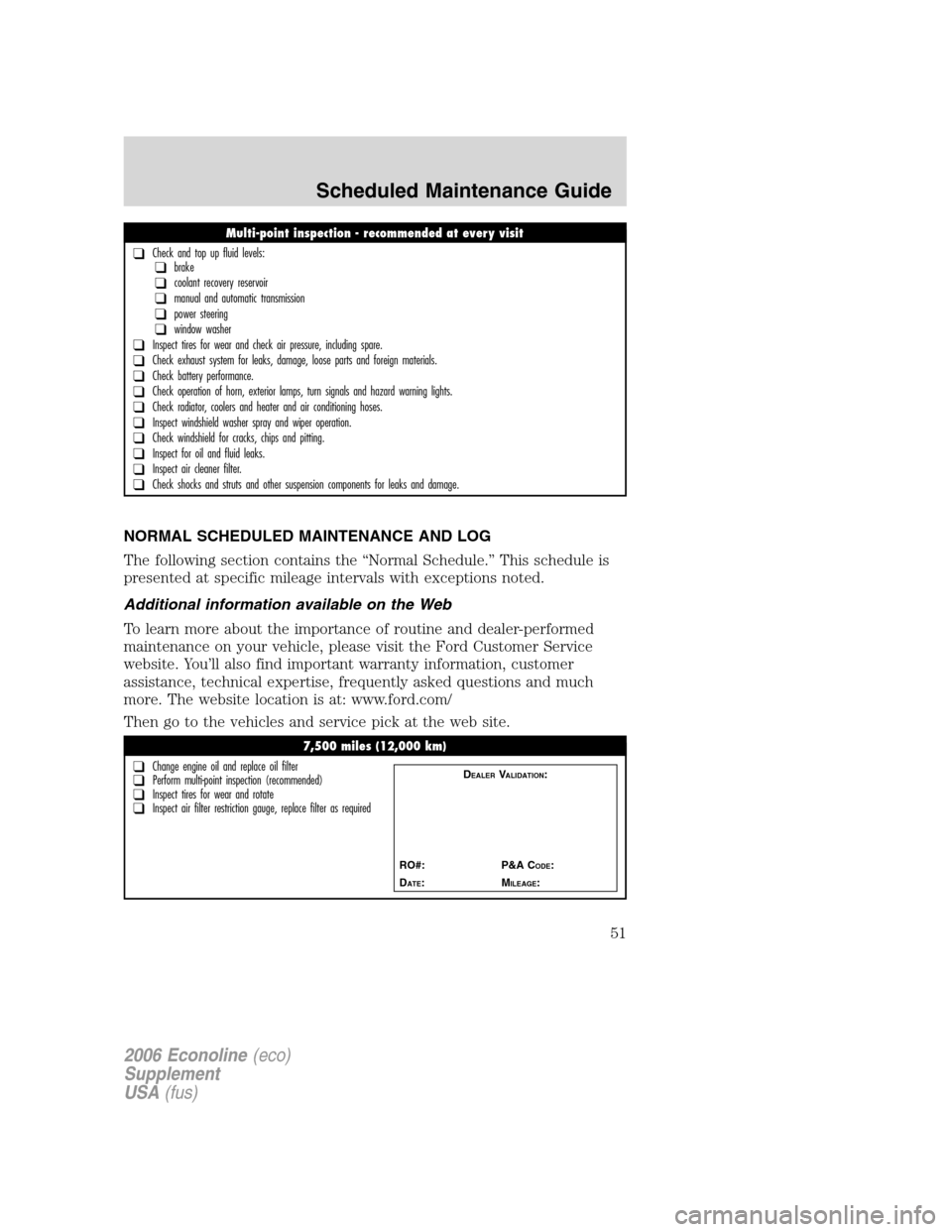
NORMAL SCHEDULED MAINTENANCE AND LOG
The following section contains the “Normal Schedule.” This schedule is
presented at specific mileage intervals with exceptions noted.
Additional information available on the Web
To learn more about the importance of routine and dealer-performed
maintenance on your vehicle, please visit the Ford Customer Service
website. You’ll also find important warranty information, customer
assistance, technical expertise, frequently asked questions and much
more. The website location is at: www.ford.com/
Then go to the vehicles and service pick at the web site.
Multi-point inspection - recommended at every visit
❑Check and top up fluid levels:❑brake
❑coolant recovery reservoir
❑manual and automatic transmission
❑power steering
❑window washer
❑Inspect tires for wear and check air pressure, including spare.
❑Check exhaust system for leaks, damage, loose parts and foreign materials.
❑Check battery performance.
❑Check operation of horn, exterior lamps, turn signals and hazard warning lights.
❑Check radiator, coolers and heater and air conditioning hoses.
❑Inspect windshield washer spray and wiper operation.
❑Check windshield for cracks, chips and pitting.
❑Inspect for oil and fluid leaks.
❑Inspect air cleaner filter.
❑Check shocks and struts and other suspension components for leaks and damage.
7,500 miles (12,000 km)
❑Change engine oil and replace oil filter❑Perform multi-point inspection (recommended)❑Inspect tires for wear and rotate❑Inspect air filter restriction gauge, replace filter as required
DEALERVALIDATION:
RO#: P&A C
ODE:
D
ATE:MILEAGE:
2006 Econoline (eco)
Supplement
USA (fus)
Scheduled Maintenance Guide
51